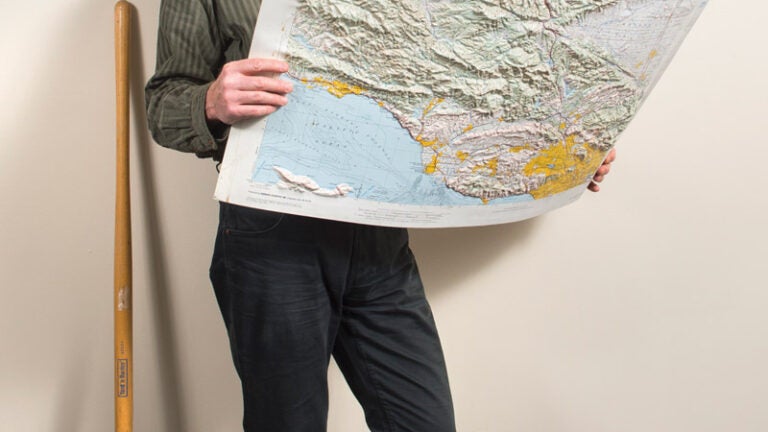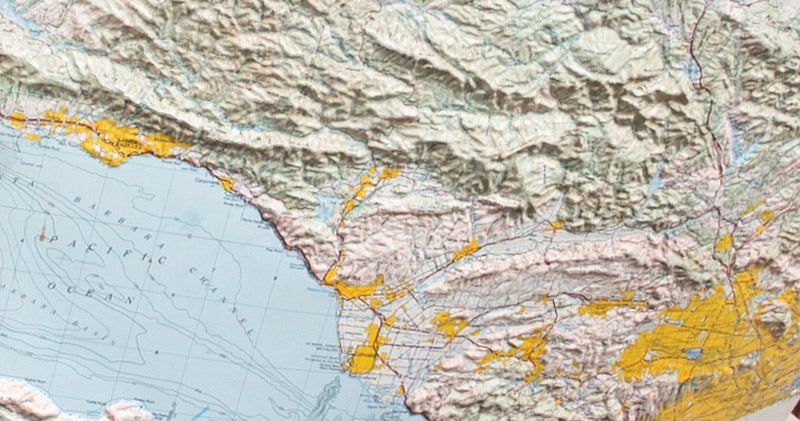
‘Geologic Detective’ Unearths L.A.’s Seismic Secrets
The Southland is being torn apart in ways we are only beginning to understand. Just ask James Dolan.
Beneath Los Angeles rise peaks of staggering height—an unnamed mountain range standing nearly 2 miles tall. Though they rival the San Gabriels in stature, you can’t see them: They’re hidden beneath LA’s flat, sprawling coastal plain, entombed beneath sand and gravel deposited over millennia by countless floods.
But James Dolan knows where they are.
Dolan’s title at the USC Dornsife College of Letters, Arts and Sciences is professor of Earth sciences. He describes himself as an earthquake geologist. But he’s perhaps best understood as a sort of geologic detective, hunting for clues about the tectonic structures that underlie our city and the forces that menace it.
Below this metropolis of some 18 million people, two huge pieces of the earth’s crust grind past each other. A kink in the boundary between those two plates, an S-shaped curve in the San Andreas Fault, compresses and fractures the rocks beneath Southern California in especially complicated ways. One such fracture heaved up the San Gabriel Mountains. Another fault slices through the city in an almost unbroken line from Malibu to Pasadena. Yet another lurks deep below the San Fernando Valley, unknown to geologists until it suddenly announced itself on Jan. 17, 1994, through the deadly Northridge earthquake.
“At the end of my career, I want to look back and say that I had a leading role in generating the data that allows us to create a time-space movie of how all the faults on the plate boundary are moving relative to one another,” Dolan said. “We’re right at the cusp of being able to see patterns emerge.”
Geologic reconnaissance Angelenos have long heard warnings about “the Big One,” a seismic event that will rumble through their city and test their preparedness when the San Andreas inevitably ruptures. But in 1995, a paper on which Dolan was the senior author raised new concerns about earthquakes along little-known urban faults that lie directly under the city.
Since then, much of his work has focused on finding those faults and measuring their potential impact. It’s a daunting task.
“They’ve got a city plopped on top of them,” Dolan said. “That makes studying them extremely difficult.”
Property owners in Los Angeles don’t usually invite geologists to dig up their yards and search for seismic hazards.
Ideally, Dolan studies a fault by digging a trench in the ground, as he did last summer along California’s San Andreas and Garlock faults. He then looks for discontinuities in the layers of soil, sand and stone. By measuring that offset, he can determine how often the fault slips and by how much.
This research is what Dolan and other scientists affiliated with the Southern California Earthquake Center, a research collective headquartered at USC and representing more than 600 scientists from dozens of institutions, use to generate intermediate-term earthquake forecasts and assess the risk a fault poses to human life and property.
But property owners in Los Angeles don’t usually invite geologists to dig up their yards and search for seismic hazards.
Most faults in urbanized areas require that you dig up streets or wait until a building is torn down to look at the foundation excavations,” Dolan said. “Permitting takes forever.”
Even without digging, though, Dolan can study subtle clues in the landscape.
“Many parts of the city that these faults traverse were developed quite early in the teens and ’20s before the advent of mechanized grading equipment,” Dolan said. “So rather than just flattening the landscape to build, we draped the city over the existing landscape.”
From his office, where maps cover practically every wall and table, Dolan can look for clues in aerial photography, old USGS quadrangle maps and even Google Earth.
And in his early fault-mapping years, Dolan resorted to two-wheeled geologic reconnaissance.
“I used to be an avid cyclist, and it’s amazing how that can attune your perception of very fine changes in grade—quarter-of-percent changes,” said Dolan, who used his bicycle to help map the Santa Monica and Hollywood faults. “It’s an effective means of seeing these subtle upwarps that can be related to active faulting.”
A gentle uptick in grade could signal that he was climbing an alluvial fan—a collection of sand, gravel and other sediments that spilled out of the nearby Santa Monica Mountains.
A more pronounced slope might indicate a fault scarp—a vertical, clifflike feature where past earthquakes have heaved up land on one side of the fault relative to the other.
“When I was riding around on my bike,” Dolan said, “it was almost as if I could mentally remove the city and look at the underlying landscape.”

Dolan was among the first to map both the Santa Monica and Hollywood faults, and his findings are of more than strictly academic interest.
But some faults are visible to the untrained eye, too. Take the Santa Monica Fault, for instance. For a mile or so, the fault reveals itself as an obvious south-facing scarp—a sudden 7- to 12-meter rise—along the north side of Santa Monica Boulevard. The fault scarp actually determined the path of the boulevard, which was originally a trolley line, Dolan said.
“Trolleys don’t like going up and down hills, so they built it along the base of the slope.”
Perhaps the best place to see the fault is the sloping lawn in front of the Mormon temple at Santa Monica Boulevard and Overland Avenue: “It’s one of the most beautifully landscaped fault scarps in the world.”
Dolan was among the first to map both the Santa Monica and Hollywood faults, and his findings are of more than strictly academic interest.
The Alquist-Priolo Earthquake Fault Zoning Act of 1972 bans the construction of new buildings directly atop an active fault’s surface trace, and for good reason. If a strike-slip fault like the Santa Monica or Hollywood were to rupture in an earthquake, the ground would be torn in two, with the two sides rushing past each other at speeds of several thousand miles per hour.
“When that happens, anything built athwart the fault will be cut in half,” Dolan said. “It’s just common sense.”
Recently, a dispute over the Hollywood fault’s exact location delayed construction of the controversial Millennium Hollywood high-rise development near the Capitol Records Tower.
Last summer’s Napa earthquake proved the danger of building directly atop an active fault’s surface trace. On Aug. 24, a previously unmapped fault ruptured directly through a suburban neighborhood. Although the ground slipped along the fault line by only 4 to 8 inches, the shearing action—distinct from ground shaking—was enough to buckle asphalt roads and snap water lines. One house straddled the fault’s surface trace. Its hardwood floors were shredded.
Living in earthquake country
Aside from several months at sea as a marine geophysicist, Dolan has called earthquake country home his entire life. Raised in the East Bay near San Francisco, Dolan moved to Los Angeles 25 years ago.
Shortly before leaving one earthquake city for another, he experienced firsthand one of California’s most destructive temblors: the 1989 Loma Prieta quake that famously interrupted the World Series.
A baseball fan, Dolan had been at the Oakland-Alameda County Coliseum for the first two games between the San Francisco Giants and Oakland Athletics—“a dream come true.”
On the afternoon of Oct. 17, he drove to a friend’s house near Santa Cruz to watch Game 3 on television. As he raised his hand to knock on the door, powerful seismic waves were speeding toward him from the epicenter some 10 miles away. The instant his knuckles made contact with the door, the ground began roiling beneath him.
It was a conscious decision not to live anywhere that I thought would be seismically vulnerable.
James Dolan
“I use doorbells now,” he joked.
Dolan delights in sharing that experience with his students at USC: “It’s a wonderful teachable moment for students, to illustrate the importance of the type of geological materials right underneath your feet.”
During the Loma Prieta earthquake, he was able to remain standing and weave down the driveway to the street. “It was like walking on a ship in heavy seas,” he said.
But a mile away in downtown Santa Cruz, a friend whom Dolan describes as an “exceptional athlete” couldn’t even remain on his feet. The earthquake flung him to the ground three separate times.
The difference? Dolan was standing atop “nominal bedrock.” His friend was on river gravels — “soft sediments that amplified shaking by an order of magnitude.” That amplified shaking reduced much of downtown Santa Cruz to rubble.
Dolan’s understanding of how earthquakes can feel remarkably weaker or stronger depending on one’s geologic location has influenced where he lives. He and his wife — also a geology professor — live in a century-old Craftsman atop older alluvium. “It’s a step down from bedrock, but still very firm,” he said.
“It was a conscious decision not to live anywhere that I thought would be seismically vulnerable.”
After moving in, Dolan and his wife immediately retrofitted their new house, adding a concrete foundation that would keep their wood-frame structure upright in an earthquake.
Safety was one motivation for the structural upgrade, but so was his reputation.
“It would be horrifically embarrassing to show pictures of my own house in my GE class as part of a cautionary tale in seismic retrofitting,” he said.
Underground mountains
Relying on Dolan’s groundbreaking studies, the California Geological Survey has been developing official, definitive maps of the Hollywood and Santa Monica fault zones — maps that will save lives and property by steering development away from active fault traces.
But of all the geologic mysteries Dolan has solved, none may be greater than the question: What hazards lurk undiscovered, deep beneath the surface?
In the 1990s, Dolan was part of the team led by Harvard geologist John H. Shaw that identified what may be LA’s gravest seismic threat: the Puente Hills blind thrust fault.
“If you set out to design a worst-case scenario fault for LA, you’d come up with the Puente Hills thrust,” Dolan said.
It’s the Puente Hills blind thrust fault — “blind” because it doesn’t break the surface — that produced the mountain range entombed deep beneath Los Angeles.
Every year my commute from my office to my house gets a little bit shorter — 5 millimeters a year every year — because Southern California is being squeezed from north to south.
Divided into three related segments, the fault underlies much of Los Angeles and Orange counties. From a point some nearly 2 miles below USC, its Los Angeles segment dips at a 27-degree angle to the abysmal depths beneath the San Gabriel Mountains. Above its highest point but beneath the surface, successive earthquakes along the fault have deformed the rock to produce folds — geologic structures that, were they above ground, we’d recognize as mountains.
When the fault ruptures, its geometry directs enormous amounts of energy up toward the flat coastal plain now home to millions. But it hasn’t ruptured in historical times. Instead, the slow, unrelenting movement between the Pacific and North American plates has compressed the rocks on each side of the fault.
Geologists have measured that compression with sensitive GPS equipment. One station is located atop USC’s Parking Center, next to the 110 freeway. Another is located at the Jet Propulsion Laboratory, near where Dolan lives.
“Every year my commute from my office to my house gets a little bit shorter — 5 millimeters a year every year — because Southern California is being squeezed from north to south,” Dolan said.
That squeezing will continue until the rocks can’t contain the enormous amounts of elastic strain energy. Then, in an instant, that stored energy will release itself as the rocks beneath Los Angeles break along their weakest point at supersonic speeds. Subtle corrugations in the land — newborn hills — may rise above the fault as the earthquake deforms the surface. The Los Angeles River may flow backwards. So might water mains and sewers.
And, for a brief but terrifying moment, everyone in Los Angeles will feel the mountains they cannot see.



